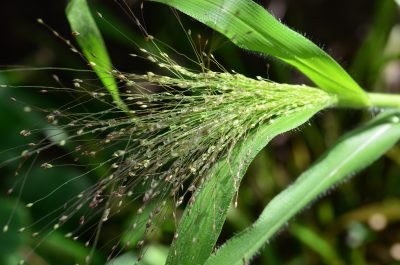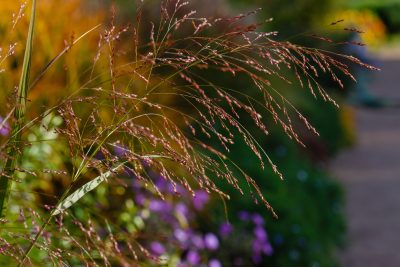The exceptional rainfall this growing season brought forth an abundance of forage on rangelands and pastures across the state. In some cases, this moisture prompted a flush of growth from annual plant species not commonly seen.
Case study and background
A recent contact to the Johnson County Extension office reported the presence of an unknown grass and non-predator losses of mature ewes while grazing upland pasture. A discussion with the local weed and pest district identified fall panicum (Panicum dichotomiflorum) on the piece of land where the sheep were grazing. While correlation does not equal causation in most cases, this time the pieces fell together. Fall panicum can be toxic to livestock.

Fall panicum is a native warm season, annual grass related to the annual witchgrass (Panicum capillare) and the warm season, perennial switchgrass (Panicum virgatum), all in the Panicum genus. These grasses are sometimes called panic grasses in reference to their open, airy panicle seed head structure.
Of note, P. dichotomiflorum and P. capillare share the common name witchgrass, which can create confusion. These may be correctly distinguished by the hairy stems of P. capillare and the hairless stems of P. dichotomiflorum. For the purpose of this article, witchgrass refers to P. capillare.
Witchgrass is a widely distributed weedy species frequently seen in disturbed areas. Switchgrass is not common in Wyoming, except for at the eastern margins of the state. Fall panicum is not common in Wyoming, which makes the above report a standout case study.
Panicum effects in livestock
Panicum grasses are known to contain steroidal saponins, which are chemical compounds that can cause photosensitization, gallbladder obstruction, liver failure, and death of livestock in severe cases.

Ruminant livestock are usually able to tolerate the toxic components of these grasses under normal conditions because they are metabolized and neutralized by microbes in the rumen. The precise mechanism of toxicity is unknown, and sometimes animals can graze panicum grass species with no complications. However, some evidence suggests that fungal mycotoxins can compound the effects of the saponins in a way that the rumen cannot overcome, resulting in toxicosis.
Fungal growth requires humidity, which many parts of Wyoming have experienced this growing season due to the higher than average precipitation. For the producer who experienced livestock loss in this case study, conditions aligned in a perfect storm.
Panicum toxicity can cause many different symptoms in livestock. Photosensitization includes skin redness and sores, especially on the muzzle, around the eyes, and other areas not covered by hair or wool; shade-seeking behaviors may become pronounced. Animals may appear lethargic and their stool may become loose. Swelling of the lips and then of the entire head may occur.
Yellowing of the eyes and jaundice can set in as liver failure progresses. Incidents of fatal liver failure in horses, goats, and sheep have been associated with the consumption of panicum grasses.
Management strategies
As with many things, the dose makes the poison. A few stray plants in a hay field or grazing allotment does not mean immediate death for any animal that dares to nibble a bite. Likewise, pastures in which panicum grasses are the predominant species should be grazed with caution. Feeding panicum-free hay prior to turnout on pasture containing a high proportion of panicum grasses can help reduce appetite and intake while also making use of the available forage.
Note that pasture and hay containing fall panicum, witchgrass, and switchgrass is never recommended for horses because they do not have the biological ability to neutralize the toxins.
The simplest and best management strategy is to remove livestock from an area with a large population of panicum grasses when possible, especially when conditions have been wet and the likelihood of fungal growth is high. Affected livestock typically recover rapidly following this change in diet.
Since fall panicum and witchgrass are both annual grasses, a targeted pre-emergent herbicide application can provide effective management while minimizing harm to desirable perennial forage grasses. Herbicide applications should be considered only when these species are overtaking pasture. Consult your local Wyoming Weed and Pest District office for product recommendations and application rates.
When panicum grass species are present in forage, graze only with ruminant livestock. If signs of toxicity occur, immediately remove them from the site and provide a panicum-free recovery diet. As always, keep an eye out for unusual plants and be
aware of what is growing in the local environment.
Micah Most is the University of Wyoming Extension agriculture and natural resources educator serving Johnson County. He can be reached at mmost@uwyo.edu or (307) 684-7522.




